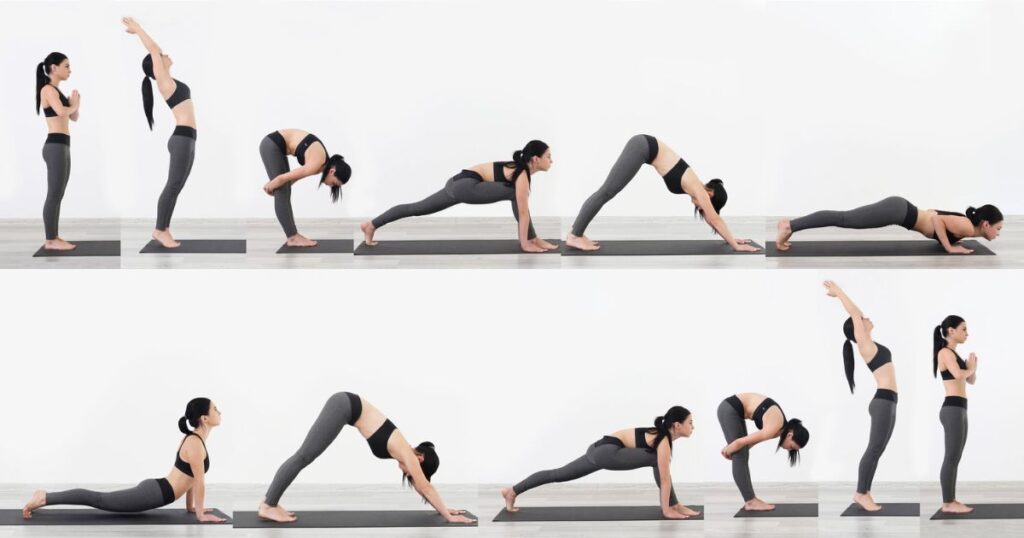Sun Salutation B, also known as Surya Namaskar B, is a dynamic yoga sequence designed to build heat, increase flexibility, and cultivate a mindful connection between breath and movement. While its cousin, Sun Salutation A, focuses on a foundational flow, Sun Salutation B integrates additional postures, creating a more vigorous and challenging practice.
This comprehensive guide delves into the world of Sun Salutation B, exploring its benefits, proper technique, variations, modifications, safety considerations, and integration into a well-rounded yoga practice.
Read More: Digital News Planet
Benefits of Sun Salutation B
Sun Salutation B offers many advantages for both the body and mind. Here’s a closer look at its key benefits:
- Increased Strength and Stamina: The repetitive nature of the sequence, combined with lunges, planks, and warrior poses, strengthens major muscle groups, improves core stability, and enhances overall endurance.
- Improved Flexibility: The sequence incorporates forward folds, high planks, and lunges, which effectively stretch the hamstrings, calves, spine, shoulders, and hips, promoting a greater range of motion.
- Cardiovascular Benefits: The flowing nature of the practice elevates heart rate, promoting healthy circulation and improving cardiovascular health.
- Boosted Energy Levels: The dynamic movements generate heat within the body, leaving you feeling energized and invigorated.
- Stress Reduction: Focusing on the breath and coordinated movements helps quiet the mind and reduce stress and anxiety.
- Improved Balance: Sun Salutation B challenges your balance with lunges, warrior poses, and downward-facing dogs, enhancing proprioception and stability.
- Weight Management: The practice burns calories and helps build muscle, which can support weight management efforts.

Breakdown of Sun Salutation B
Sun Salutation B consists of 19 sequential postures, linked by coordinated breaths. Here’s a step-by-step breakdown of the sequence:
- Tadasana (Mountain Pose): Stand tall with your feet hip-width apart, grounding through your soles, and engage your core. Breathe deeply.
- Pranamasana (Prayer Pose): Inhale, bringing your palms together at your heart center.
- Hasta Uttanasana (Extended Hand Pose): Exhale, hinge at your hips, and lengthen your spine as you fold. Reach your hands towards the floor, or place them on blocks if needed.
- Adho Mukha Svanasana (Downward-Facing Dog): Inhale, push your hips back, and straighten your legs, forming an inverted V-shape. Lengthen your spine and press your heels towards the floor.
- Chaturanga Dandasana (Four-Limbed Staff Pose): Exhale, and lower your body towards the mat, keeping your elbows close to your body and your core engaged. Form a straight line from head to heels.
- Urdhva Mukha Svanasana (Upward-Facing Dog): Inhale, push through your hands and feet, lifting your chest and upper body off the mat. Arch your back and gaze upward.
- Adho Mukha Svanasana (Downward-Facing Dog): Exhale, and return to downward-facing dog.
- Ashwa Kanchanaasana (High Lunge Pose): Inhale, step one leg forward between your hands, lowering your back knee towards the mat. Keep your torso upright and hips squared.
- Virabhadrasana I (Warrior I Pose): Exhale, reach your arms overhead, aligning them with your front leg. Engage your core and lengthen your spine.
- Adho Mukha Svanasana (Downward-Facing Dog): Inhale, step your back foot back, returning to downward-facing dog.
- Ashwa Kanchanaasana (High Lunge Pose) – Opposite Leg: Repeat steps 8 and 9 with the opposite leg.
- Adho Mukha Svanasana (Downward-Facing Dog): Inhale, step your back foot back, returning to downward-facing dog.
- Utkatasana (Chair Pose): Exhale, bend your knees, and lower your hips as if sitting in a chair. Keep your back straight and core engaged. Reach your arms overhead.
- Adho Mukha Svanasana (Downward-Facing Dog): Inhale, straighten your legs, returning to downward-facing dog.
- Ardha Uttanasana (Halfway Lift): Inhale, hinge at your hips, and fold forward, lengthening your spine. Keep your knees slightly bent.
- Uttanasana (Standing Forward Fold): Exhale, reach your hands towards the floor, or place them on blocks. Lengthen your spine and relax your head towards the ground.
- Pranamasana (Prayer Pose): Inhale, and rise slowly, bringing your spine to an upright position. Join your palms at your heart center.
- Tadasana (Mountain Pose): Exhale, release your arms to your sides, and return to a standing mountain pose. Breathe deeply.
- Repeat: This completes one round of Sun Salutation B. Aim for 3-5 rounds, depending on your fitness level and practice goals.

Tips for Practicing Sun Salutation B:
- Focus on your breath: Coordinate your breath with each movement. Inhale as you lengthen and expand, and exhale as you fold or contract.
- Maintain proper alignment: Engage your core and keep your spine long throughout the practice.
- Move with intention: Focus on each posture and transition smoothly between them.
- Listen to your body: Don’t push yourself beyond your limits. Modify the poses as needed, and take breaks when necessary.
- Warm up beforehand: Prepare your body for the practice with gentle stretches or light cardio.
Variations of Sun Salutation B
Sun Salutation B offers various modifications to accommodate different levels and physical limitations. Here are some common variations:
- For Beginners:
- Reduce the number of repetitions: Start with a few rounds and gradually increase as you gain strength and flexibility.
- Modify challenging poses:
- In Chaturanga Dandasana (Four-Limbed Staff Pose), lower your knees to the floor instead of lowering your entire body.
- In Downward-Facing Dog, keep your knees bent slightly if your hamstrings are tight.
- Use props: Utilize blocks for support in forward folds and downward-facing dogs.
- For Advanced Practitioners:
- Increase the number of repetitions: Aim for more rounds or practice a faster flow.
- Hold poses for longer: Deepen the stretch by holding each posture for a few breaths.
- Incorporate additional variations: Explore advanced poses, such as lifting a leg in Downward-Facing Dog or transitioning from High Lunge directly to Warrior III.

Remember: It’s crucial to choose modifications that suit your body and fitness level. Don’t hesitate to consult a yoga teacher for guidance on appropriate variations.
Safety Considerations
Sun Salutation B is a generally safe practice for most healthy individuals. However, it’s important to be mindful of potential risks and practice with caution. Here are some safety considerations:
- Pre-existing injuries: If you have any injuries, especially in your wrists, knees, or back, consult your doctor before practicing Sun Salutation B.
- Pregnancy: Modify or avoid the practice during pregnancy, particularly poses that put stress on the abdomen.
- High Blood Pressure: Certain poses in Sun Salutation B can elevate blood pressure. If you have high blood pressure, consult your doctor before practicing.
- Listen to your body: Pay attention to any pain or discomfort you experience during the practice. Stop and rest if necessary.
Integrating Sun Salutation B into Your Yoga Practice
Sun Salutation B can be a valuable addition to your overall yoga practice. Here are some ways to integrate it:
- Warm-up sequence: Practice Sun Salutation B at the beginning of your yoga class to warm up your body and prepare for more advanced postures.
- Stand-alone practice: You can practice Sun Salutation B as a standalone practice for a quick and energizing workout.
- Flow sequence: Combine Sun Salutation B with other yoga poses to create a flowing vinyasa sequence.
No matter how you choose to incorporate it, Sun Salutation B offers a dynamic and energizing way to enhance your yoga practice and cultivate a sense of well-being.
FAQs:
1: What is the difference between Sun Salutation A and Sun Salutation B?
Sun Salutation A is a foundational sequence with 12 postures, focusing on basic movements like lunges, forward folds, and plank variations. It’s a good starting point for beginners.
Sun Salutation B is a more advanced variation with 19 postures, incorporating additional poses like high lunge, warrior I, and upward-facing dog. It offers a more vigorous workout and requires a stronger foundation in Sun Salutation A.
2: How many steps are in Sun Salutation B?
Sun Salutation B consists of 19 sequential postures, linked by coordinated breaths.
3: What is the breathing pattern for Sun Salutation B?
In Sun Salutation B, generally:
- Inhale during lengthening and expanding movements (e.g., reaching up in Tadasana, lifting your chest in Upward-Facing Dog).
- Exhale during folding or contracting movements (e.g., hinging forward in Downward-Facing Dog, lowering your body in Chaturanga Dandasana).
4: How much Surya Namaskar per day?
There’s no one-size-fits-all answer. It depends on your fitness level and goals. Beginners can start with 3-5 rounds, and experienced practitioners can do more. Listen to your body and gradually increase repetitions as you get stronger.





